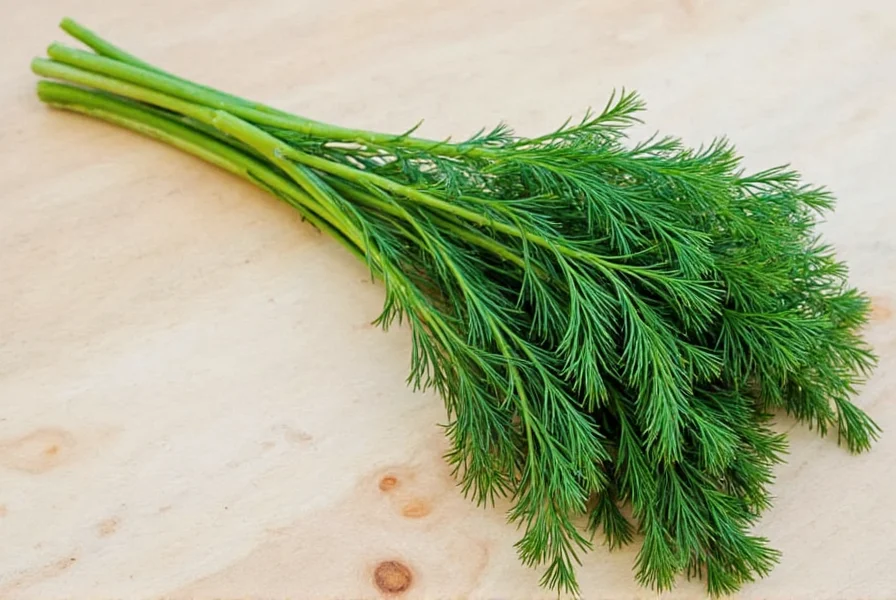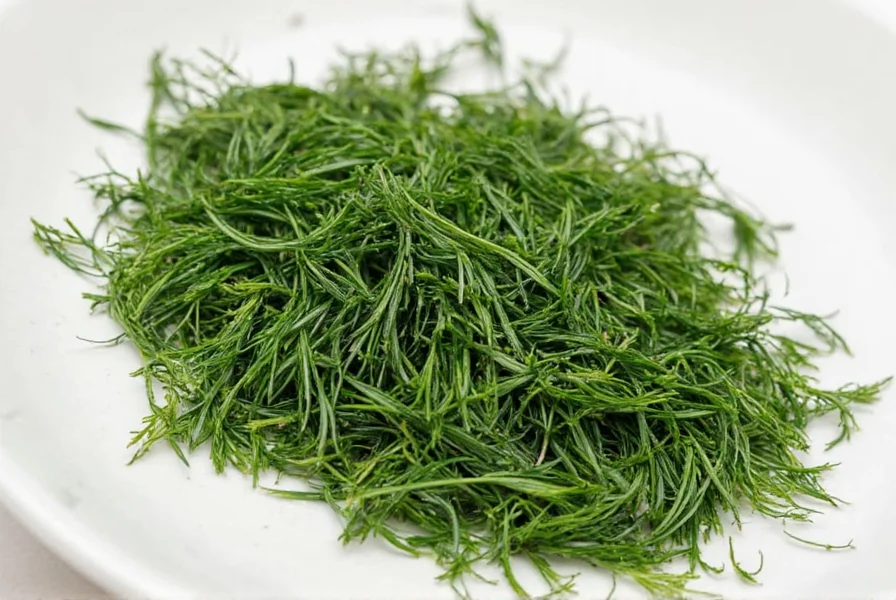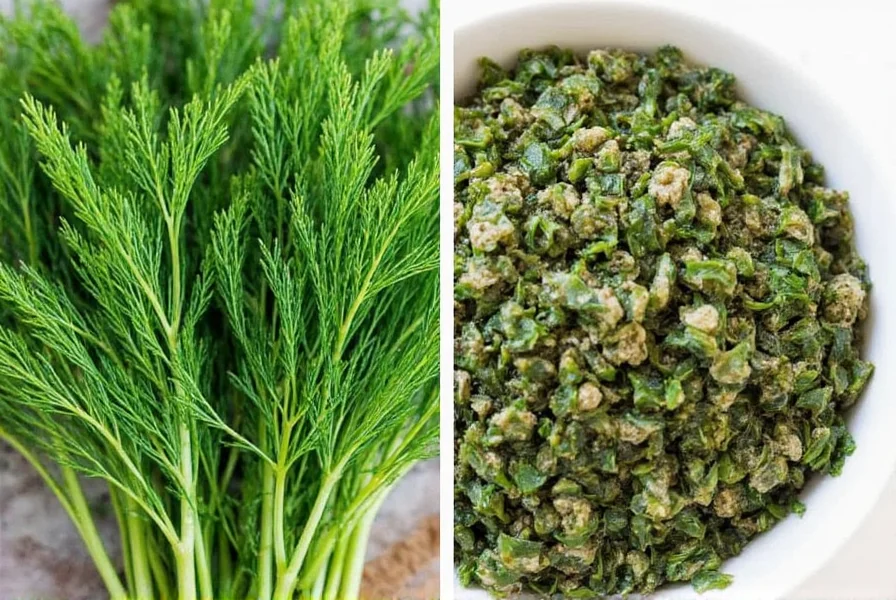| Aspect | Dill Weed | Dried Dill |
|---|---|---|
| Harvest Time | Early growth stage | Late season, after flowering |
| Texture | Tender, leafy | Crispy, brittle |
| Flavor Intensity | Mild, bright, grassy | |
| Storage | Refrigerate, short shelf life | Store dry, lasts months |
| Best For | Garnishes, cold dishes | Cooking, pickling, soups |
Introduction: Dill Weed vs Dried Dill — What's the Difference?
No, dill weed and dried dill are not the same thing. While both come from the same plant (Anethum graveolens), they differ significantly in harvest time, flavor profile, and best uses. Here's a quick overview of the key differences:
- Harvest Time: Dill weed is harvested early in the plant's growth, while dried dill comes from mature leaves and stems.
- Flavor: Fresh dill weed has bright, citrusy notes; dried dill is more concentrated and earthy.
- Best Uses: Use fresh dill for garnishes and cold dishes; dried dill is ideal for cooking, pickling, and baking.
Now, let's dive deeper into each aspect to help you use them correctly in your cooking.
What Exactly Is Dill?
Dill (Anethum graveolens) is an aromatic annual herb that belongs to the parsley family. Native to the Mediterranean and parts of Asia, it has feathery leaves and yellow flowers. Both the leaves and seeds are used in cooking — but today we're focusing on the leaves, specifically dill weed and its more mature cousin, dried dill.
The Two Faces of Dill:
- Fresh Dill Weed: The young, tender green leaves harvested before flowering.
- Dried Dill: Usually made from mature leaves, sometimes including stems or seed heads, and dehydrated for long-term storage.

Taste Test: Which One Packs More Punch?
If you were to place a sprig of fresh dill weed next to some dried dill and give each a sniff or a taste, you'd immediately notice the difference.
Fresh Dill Weed
- Light, citrusy notes
- Herbal aroma with a touch of anise
- Perfect for adding a delicate finish
Dried Dill
- Stronger, more pungent flavor
- Slightly bitter edge
- Better suited for slow-cooked dishes where it can infuse gradually
Because of their different flavor profiles, substituting one for the other can dramatically change your dish — especially if you're pickling cucumbers or making a creamy dill sauce.
When to Use Each: Cooking Tips for Dill Lovers
Knowing when to reach for fresh dill weed versus dried dill is like knowing whether to wear flip-flops or boots — it depends on the weather… and the recipe!
Top 5 Uses for Fresh Dill Weed
- Garnishing: Sprinkle on salmon, potato salad, or soups just before serving.
- Cold Dishes: Perfect for cucumber salads, tzatziki, and dips.
- Egg Dishes: Add to scrambled eggs or deviled eggs for a fresh kick.
- Pesto: Blend with olive oil, garlic, and Parmesan for a unique version of pesto.
- Sushi Rolls: Adds a fragrant herbal note to homemade sushi.
Top 5 Uses for Dried Dill
- Pickling: Essential ingredient in classic dill pickles.
- Stews & Soups: Releases deeper flavor when simmered slowly.
- Rub for Meats: Mix with salt and pepper for a smoky chicken or pork rub.
- Baking: Used in savory breads and cheese scones.
- Marinades: Blends well with vinegar, mustard, and olive oil.
Buying Guide: Choosing the Best Dill Products
Whether you're buying fresh dill weed or dried dill, quality matters. Here's how to make smart choices:
For Fresh Dill Weed
- Look: Vibrant green color, no wilting or yellowing.
- Smell: Should be fragrant with a slight licorice note.
- Feel: Leaves should be soft and pliable, not crispy or slimy.
For Dried Dill
- Check the Packaging: Sealed tightly to preserve freshness.
- Aroma: Strong smell when opened — avoid anything musty or stale.
- Color: Deep green; brown or faded leaves indicate age and loss of flavor.
Recommended Brands
Here are some top picks across both fresh and dried categories:
Fresh Dill Bunch – Local Organic Farms
Features: Locally grown, pesticide-free, sustainably harvested.
Advantages: Crisp texture, vibrant color, perfect for immediate use.
Use Cases: Garnish, cold dishes, summer salads.
Target Audience: Home cooks and professional chefs looking for premium quality.
Occasions: Weekend brunch, garden parties, fresh seafood dinners.

Dried Dill Seasoning – SpiceCraft Naturals
Features: Air-dried without preservatives, resealable pouch.
Advantages: Long shelf life, potent flavor, easy to measure.
Use Cases: Pickling, marinades, baked goods, hearty stews.
Target Audience: Picklers, home bakers, meal preppers.
Occasions: Winter comfort food, holiday gifting, preserving season harvests.
Bonus Tip: Can You Grow Your Own Dill?
Want total control over your dill supply? Try growing your own! It's surprisingly easy and super rewarding.
Quick Growing Guide:
- Location: Sunny spot (6+ hours of direct sunlight).
- Soil: Well-draining, slightly acidic to neutral pH.
- Water: Moderate watering — don't let it dry out completely.
- Harvest: Pick leaves when the plant is 8–12 inches tall.

Pro tip: If you want a steady supply of dill weed, plant new seeds every few weeks. And if you let a few plants flower, you'll also get dill seeds — great for pickling too!
Frequently Asked Questions
Are dill weed and dried dill the same thing?
No, dill weed and dried dill are not exactly the same. Dill weed typically refers to the fresh, tender leaves of the dill plant harvested early in its growth cycle. Dried dill is made from more mature dill leaves (and sometimes stems or seed heads) that have been dehydrated. While they come from the same plant, the harvesting time, texture, flavor profile, and best uses differ significantly.
Can I substitute dried dill for fresh dill weed in recipes?
Yes, but with important considerations. As a general rule, use 1 teaspoon of dried dill for every 1 tablespoon of fresh dill weed. However, keep in mind that dried dill has a more concentrated, earthy flavor compared to the bright, grassy taste of fresh dill weed. For cold dishes or as a garnish, fresh dill is preferable. For cooking, pickling, or baking, dried dill often works better.
Why does dried dill taste different from fresh dill weed?
Drying concentrates certain compounds while causing others to degrade. Fresh dill weed contains volatile oils that give it a bright, citrusy, almost anise-like flavor. When dried, some of these delicate compounds evaporate, while others become more concentrated, resulting in a more earthy, slightly bitter profile. The dehydration process fundamentally changes the flavor chemistry.
Which is better for pickling—dill weed or dried dill?
Traditional pickle recipes call for fresh dill weed (often with dill flowers) for the most authentic flavor. However, high-quality dried dill works well too, especially when fresh isn't available. The key is using enough quantity since dried dill's flavor needs time to rehydrate and infuse. Many professional picklers actually prefer a combination of both for layered flavor.
How long does fresh dill weed last compared to dried dill?
Fresh dill weed typically lasts 5-7 days when properly stored in the refrigerator (in a damp paper towel inside a plastic bag). Dried dill, when stored in an airtight container in a cool, dark place, maintains good flavor for 6-12 months. After this time, it doesn't spoil but gradually loses potency.
Can I make my own dried dill from fresh dill weed?
Absolutely! The best method is air-drying: tie fresh dill sprigs in small bundles and hang them upside down in a warm, dry, dark place with good airflow. Once completely dry (usually 1-2 weeks), crumble the leaves and store in an airtight container. Oven drying at the lowest setting also works but requires careful monitoring to prevent burning. Homemade dried dill often has superior flavor to store-bought.
What's the proper conversion ratio between fresh and dried dill?
The standard conversion is 3:1 - meaning 3 parts fresh dill equals 1 part dried dill. So if a recipe calls for 1 tablespoon of fresh dill weed, use 1 teaspoon of dried dill instead. However, for delicate dishes, you might want to use slightly less dried dill to prevent overpowering the other flavors.
Conclusion: Spice Up Your Kitchen with Confidence
So, are dill weed and dried dill the same? Not exactly — but now you know how they differ and when to use each for the best results.
Remember:
- Fresh dill weed = delicate, bright flavor ideal for garnishes and cold dishes.
- Dried dill = bold, concentrated flavor best for cooking, pickling, and baking.
With this knowledge in hand, you'll confidently elevate your meals — whether you're tossing a summer salad or whipping up a batch of tangy dill pickles.
So go ahead — stock your pantry wisely and season like a pro!










 浙公网安备
33010002000092号
浙公网安备
33010002000092号 浙B2-20120091-4
浙B2-20120091-4